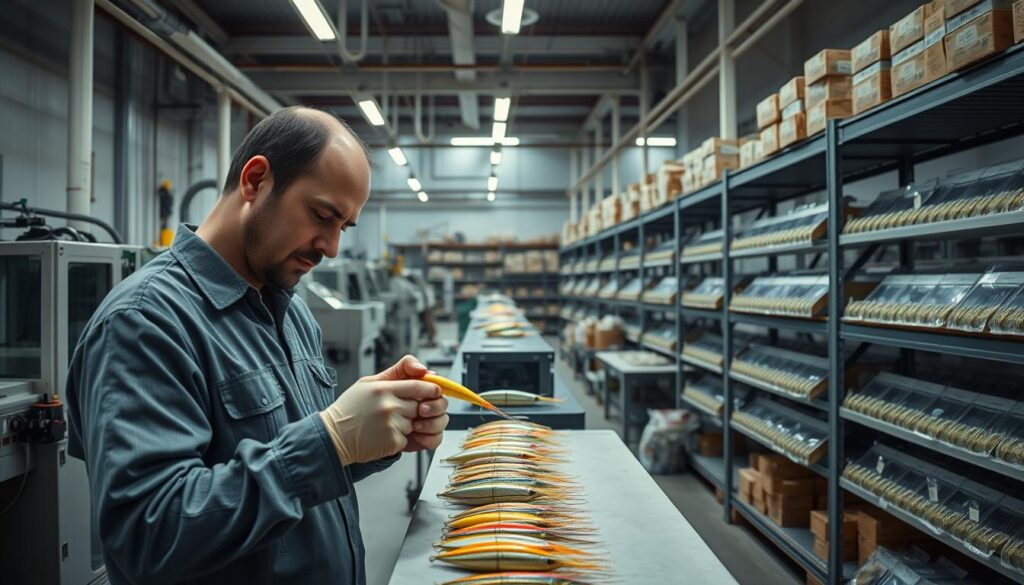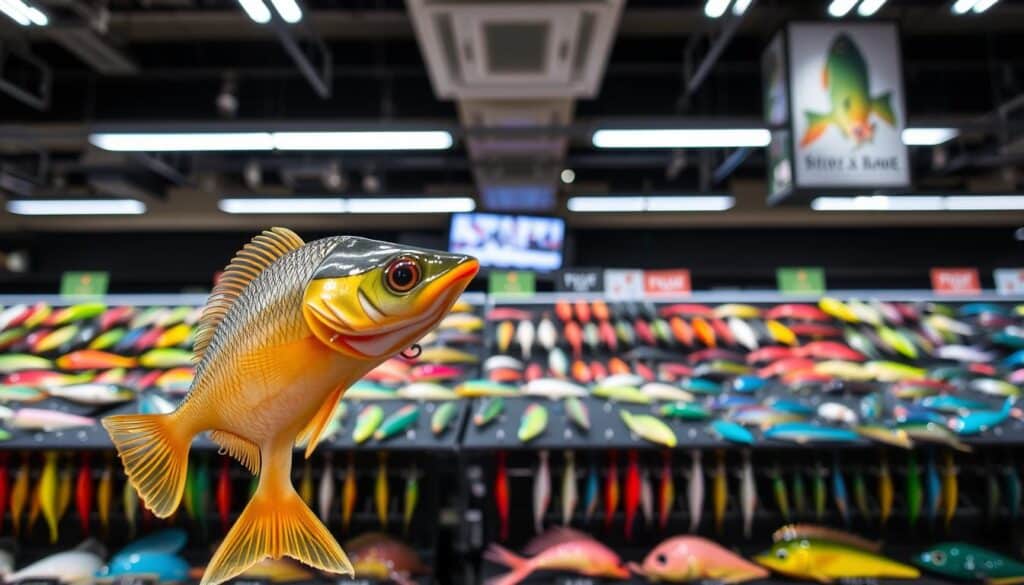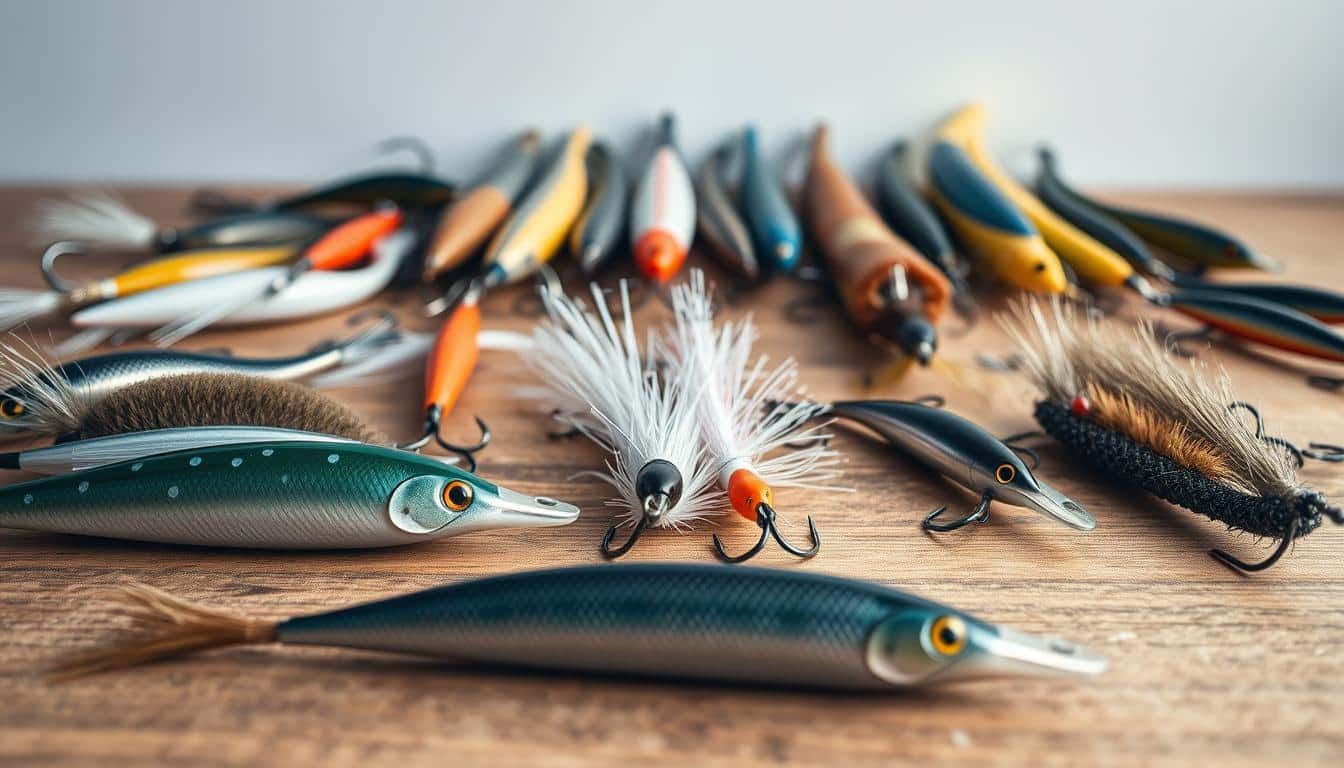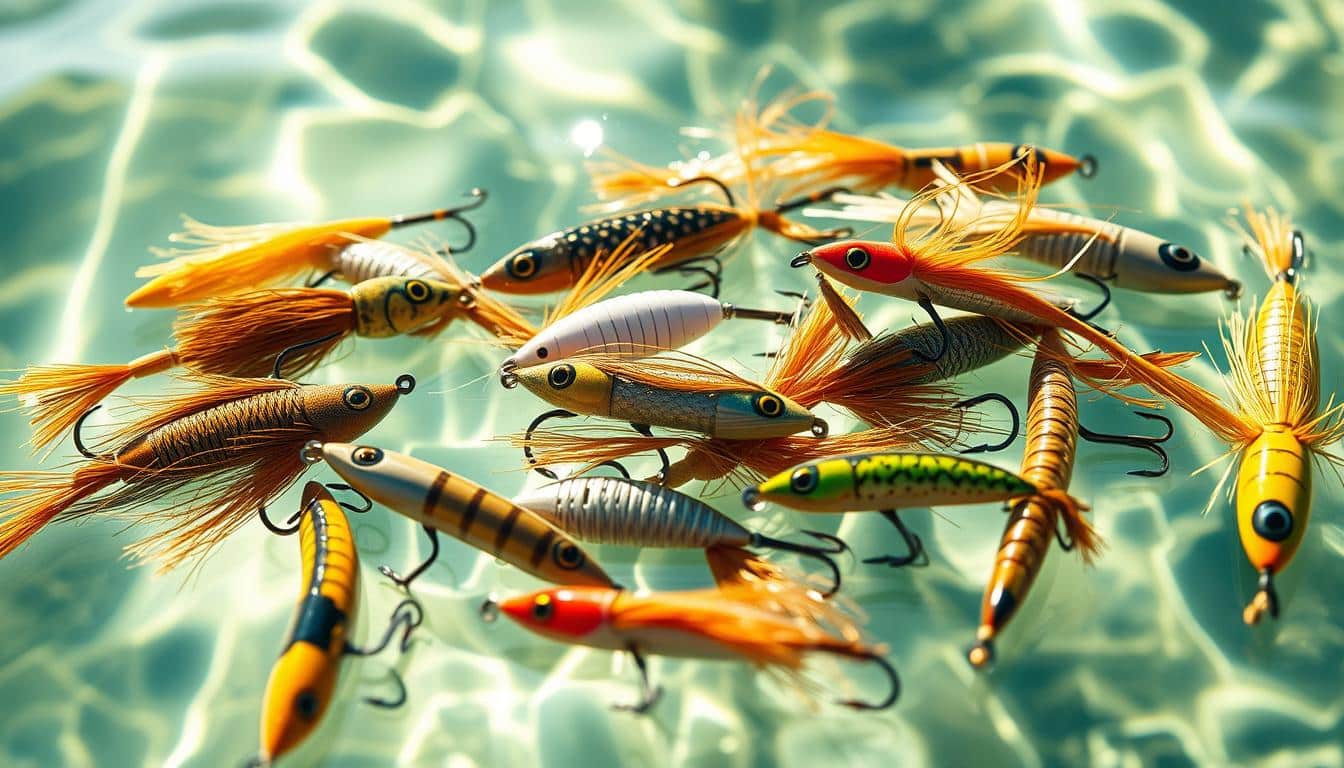Fishing gear is evolving. Anglers and creators consider both effectiveness and the environment. This means choosing baits that don’t harm our waters. The Science of Plastic-Free Lure Materials looks at non-PVC baits. These alternatives keep our fishing effective and reduce waste in our waters.
Ethan Albright, a high school student from Pennsylvania, made a difference. He created biodegradable lures out of gelatin, corn starch, and other safe materials. These lures dissolve in water after about 16 days. They work just as well as plastic ones but are better for the environment.
In Wisconsin, Ben Hobbins worked with the University of Wisconsin–Madison. They made a tough type of bait called IronClads. It’s made with microfibers that make it strong yet flexible. This means it lasts longer and reduces the waste of lost lures.
Here’s a quick look at better, environmentally friendly fishing methods. We’ll discuss why biodegradable and plastic-free lures are good for the future. The aim is clear. Use methods that are effective in catching fish but don’t hurt our planet. It’s about protecting our water, wildlife, and our own health too.
The Science of Plastic-Free Lure Materials
Anglers and manufacturers are now looking at new materials for soft baits. They’re focusing on plastic-free options. This change is becoming popular among the U.S. fishing community.
Definition and scope of plastic-free lure materials
Plastic-free lures include materials like gelatin, starch, and alginate. They’re biodegradable and safer for the environment. These materials are used to make common fishing baits through different processes. They’re also available in eco-friendly packaging.
Why anglers and manufacturers are shifting away from traditional soft plastics
Fishers want materials that work like PVC but are less harmful. Traditional soft plastics can cause pollution. They often get lost in water, creating litter that lasts for years.
People are worried about the harmful chemicals in PVC. Companies like Berkley and Yamamoto seek safer, effective alternatives. These new products aim to reduce pollution without losing performance.
How this topic ties to sustainability and pollution reduction in U.S. waterways
Choosing the right materials can decrease microplastic pollution. By using biodegradable materials, we help to limit long-term damage. We can also reduce waste by using more durable designs.
- Rapid-degrade approach: biopolymer hydrogels that break down quickly in nature.
- Longevity approach: fiber-reinforced elastomers that are more durable.
- Behavioral approach: educating anglers to choose better gear and reduce litter.
Both rapid degradation and durability help fight against fishing pollution. This leads to an industry-wide effort to find better alternatives to PVC. The goal is to protect our waterways while still providing good gear for fishers.
Environmental Impact of Soft-Plastic Fishing Lures
Every year, anglers lose millions of soft-plastic lures. They get snagged, tear, or fall off hooks. These lost lures pile up along shores, settle into the mud, and float in water. This raises big worries about how much plastic is getting into our lakes and rivers.
Quantifying lost bait in lakes, rivers, and coasts
We’re talking huge numbers of lures disappearing annually. Some estimates say about 20 million pounds of them in U.S. waterways. Others talk about more than 12,000 tons. This includes lures that wear out, get snagged, or break off.
When people clean up beaches and dive underwater, they find bits and whole lures often. Checks at popular fishing spots always find lots of soft baits. This is key info for folks studying pollution and making rules.
Microplastic formation and ecological pathways
Over time, these lures break down into tiny bits. Sunlight, waves, and wear and tear turn them into microplastics. These tiny pieces mix into mud and float around in the water.
Small creatures and fish end up eating these microplastics. Then, they get carried far away by water currents and wind. That leaves harmful chemicals in the environment for a long time. This raises big worries for everything living there.
Case studies on ingestion, retention, and health effects
Studies show many types of fish eating these plastics. For example, in Maine, many brook trout swallowed them during tests. Some fish ate so much it was over 10% of their body weight.
These lures can stay in a fish’s stomach for weeks. This can make fish eat less and lose weight. Anglers often catch fish with bellies full of these baits.
Tests in labs show harmful chemicals can move from plastics to fish. This could hurt the fish’s growth and breeding. And, it means people eating these fish could also be at risk.
- Key drivers: accidental loss, material fragility, and high angler effort.
- Pathways: fragmentation, sedimentation, and trophic transfer.
- Observed impacts: stomach retention, anorexia, and weight decline in affected fish.
Biodegradable and Edible Biopolymer Lures
Anglers and small manufacturers are testing new kinds of fishing lures. These lures are made from edible materials and can break down in nature. They use simple kitchen ingredients to make shapes like worms that fish are drawn to.
Key ingredients and simple recipes
They blend things like gelatin, corn starch, and sodium alginate. This mix creates flexible hydrogels. Baits made from gelatin stretch well thanks to the gelatin and starch. Lures made from sodium alginate turn firm when mixed with calcium lactate.
- Gelatin-based baits: warm water, gelatin bloom, optional glycerin for softness.
- Sodium alginate lures: alginate solution injected into calcium bath to set a skin.
- Flavor and colorants: spirulina, beetroot juice, turmeric, and pepper flakes for natural attractants.
Performance comparisons: buoyancy, light, and durability
Experiments compare these lures to regular ones in buoyancy and how light passes through them. These biopolymer lures can look quite similar to standard soft plastics under water.
Some ingredients make lures that float and look like regular ones. However, their toughness varies. Some gelatin recipes are stronger than cheaper plastic lures.
Keeping these baits fresh is hard. Gelatin baits might need cold storage. Using special packaging can help keep them fresh without harm to the environment.
Real-world example: field testing and retail steps
Ethan Albright made hydrogel worms and tested them in Pennsylvania. His green pumpkin, tan, and pink lures caught fish’s attention. They started breaking down in water after about 16 days.
Albright shared his methods in a detailed report. He sold them in eco-friendly packs locally, improving his recipe for better shelf life and fish appeal.
For those interested in eco-friendly fishing, these edible lures offer a new option. Trying out different materials might change how we fish while helping the planet.
Fiber-Reinforced and Durable Alternatives to PVC
Anglers and engineers are exploring new methods to improve soft baits. They’re adding tiny fibers to make them stronger yet maintain their natural movement. These innovations aim to reduce tearing and decrease the number of lures lost in bodies of water.
Engineering approach: microfibers and fiber-reinforcement to reduce tear and loss
- By incorporating microfibers into the mix, lures gain strength without becoming rigid.
- The arrangement and amount of fibers are adjusted to make lures tough against tears and losing hooks.
- With rapid prototyping, it’s quick to modify fiber layout and test how lures move in water.
Material benefits: longer life, fewer replacements, and reduced environmental loss
- Lures with added fibers withstand more casts than traditional ones, lessening waste over time.
- This means anglers buy fewer replacements, saving money and cutting down on environmental waste.
- Thanks to their durability, fewer baits are lost when snagged or bitten.
Industry example: Ben Hobbins’ IronClads and partnership with UW–Madison researchers
- Ben Hobbins created IronClads with a team from UW–Madison. They focused on how fibers can enhance durability.
- The prototypes shone at trade shows, praised for their blend of performance and longevity.
- Hobbins aimed for pricing on par with standard lures, making the advanced options accessible without a high cost.
Material Science Principles Behind Fishable Properties
Soft baits are a mix of science and fishing needs. They’re made to move just right, not tear easily, and stick on hooks. The strength and stretchability are tested in labs. This is to see how they’ll handle real fishing conditions.
Flexibility, tensile strength, and break-point considerations for lures
How bendy a lure is affects how it moves in water. If it’s too stiff, it seems dead. Too floppy, and it rips when you try to catch fish. Lures that are just right can stretch under stress but don’t break suddenly.
- Tests for breaking-point stress find out when a lure will give way.
- Elongation checks measure how much a lure can stretch before it breaks.
- Fatigue tests mimic casting and getting stuck to spot weak points.
How additives affect performance and health concerns
Some fishing lures use special chemicals to make PVC soft and feel good. But these chemicals can be tough and sometimes risky for hooks. Certain chemicals also raise environmental and health worries if they get into water or are eaten by animals.
The US has rules about some of these chemicals in kids’ stuff. Fishing gear is watched closely since lost lures end up in waterways. Using different chemicals or materials helps lessen these risks without sacrificing how well lures work.
Balancing biodegradability with functional longevity for anglers
Biodegradable materials break down faster, reducing pollution. Yet, they might not last as long during use or on the shelf. Adding fibers or layering materials can make them last longer without harming the planet. Lure makers try to make products that both work well and are eco-friendly.
Teams have to think about what anglers expect and the environment. This helps make lures that do their job without leaving a big mark on nature.
Manufacturing Methods and Scale-Up Challenges
Taking novel bait materials from lab to store is a detailed process. It involves choosing the right methods regarding cost and rules. Small teams work fast, creating prototypes to check their design and movement. For larger amounts, they rely on methods like injection molding to make consistent parts.

Molding and prototype routes
- Injection molding fits well for PVC and certain elastomers, provided the volume makes the setup cost worthwhile. It ensures parts are uniform and precise.
- For materials like biopolymer hydrogels, casting and compression molding are better to avoid damaging the material.
- 3D printing and CNC machining allow quick changes to lure designs before making permanent molds.
Primary production cost drivers
Tool making is a big expense. Steel molds cost a lot upfront but make each item cheaper in large-scale production. Next, the choice of materials like biopolymers can also push up costs, compared to standard PVC.
- Starting with small batches can cut risks with new recipes but makes each item more expensive. It also makes keeping edible products fresh harder.
- Hiring another company to do injection molding can help scale up while planning for own equipment.
- Costs for packaging, making sure products are good quality, and keeping edible baits fresh affect the price at stores.
Regulatory and safety testing hurdles
Edible and eco-friendly baits need to pass many tests. They must be safe to touch food, stay fresh, and not harm the environment. These tests check if they break down as expected and are safe for fish, people, and have a good shelf life.
- Checking that manufacturing biodegradable lures are non-toxic and break down properly in the environment.
- Doing tests to make sure edible products stay safe over time.
- Proper labels and outside checks are needed to prove biodegradability claims. This builds trust with customers and meets regulatory standards.
Teams that mix early design tests with careful cost and rule planning do better. They’re more likely to get their innovative baits used by more people.
Field Testing and Performance Metrics for Eco-Friendly Lures
Field tests turn lab claims into real fishing outcomes. They mix controlled tests with real-life use to check lure durability, fish appeal, and ease of use. This way, anglers and makers can see how new materials stack up against traditional lures.
Lure makers begin with standard lab tests. These test for strength, floatability, and how much light passes through. The results decide which lures go on to more realistic tests in different water environments.
During live tests, anglers track how often fish bite, how well the lures hook fish, and if they stay on the hook. Teams compare these results under the same fishing conditions. This ensures data is reliable and can be repeated.
Statistical analysis of lure performance sets firm benchmarks. Ethan Albright found that in terms of light passing through and floating, eco-friendly lures matched traditional plastics. But, these eco-lures proved to be stronger under test conditions.
To avoid bias, tests often hide the lure type from anglers. Anglers then share thoughts on the lure’s feel, look, and supposed durability. Also, selling lures in local shops gets feedback from actual customers before a big launch.
- Durability metrics: cycles to failure, tear length, and hook-hold time.
- Behavioral metrics: strikes per hour, hookup ratio, and linger time on structure.
- Perception metrics: angler realism score, ease of rigging, and refill intent.
Feedback from trade shows and market tests provides extra insight. Ben Hobbins used ICAST exposure and awards to gauge buyer interest. Meanwhile, Albright sold lures in 10-packs locally, noting trout reactions and whether people bought them again.
Well-planned tests use both numbers and people’s views. This blend enhances catch rate data and guides producers in perfecting their lures for the market.
Market Trends, Business Models, and Retail Adoption
In the U.S., the soft-plastic lure market is huge. Millions of pounds of these lures are made every year. If we used biodegradable or longer-lasting lures, we could greatly reduce plastic waste in our waters. Retailers and manufacturers look at how fast products sell, their prices, and whether they help reduce waste before deciding to stock them.

Startups are trying new ways to sell their eco-friendly lures. They often start by selling in local bait shops and using online ads. This helps them understand how well their products sell, which helps with planning and making deals with bigger stores.
Universities and companies are working together to make new lures faster. By working with universities, small companies can improve their lures and meet safety standards more quickly. This makes it easier for them to sell to big retailers.
Fishing lure brands usually start by selling in small stores. Then they move up to bigger chains. When deciding what to stock, big stores look at four things:
- How well the lure works and what fishers think of it.
- Price compared to regular lures.
- How long the product lasts and how it’s packaged.
- Being able to keep supplying the store reliably.
Emerging brands often follow these steps to sell their products:
- Begin by selling in local shops to get feedback.
- Expand to bigger stores in the area and go to trade shows.
- Finally, get their products into nationwide stores by meeting their requirements.
Competitive pricing is important too. Novel lures that are stronger or made from edible materials should cost about the same as or less than traditional baits. This approach helps them get into stores faster and avoids problems with unhappy customers.
Investors and retailers look for signs of a good bet. If a brand can show it reduces waste, works with universities, and keeps stores stocked, it has a better chance of becoming widely popular.
Environmental and Human Health Considerations
Materials used in soft baits can impact our waters and health. It’s important for makers and fishers to consider the chemical dangers, how long plastics last, and their breakdown in nature. This guide talks about legal issues, effects on ecosystems, and how to make smarter choices throughout a product’s life.
Phthalate risks and PVC
- PVC’s issues come from adding substances that make it soft. These additives, called phthalates, might mix with water and soil.
- California’s rules on phthalates in kids’ items hint at wider attention. This could change what’s in fishing baits and what stores sell.
- Lost or thrown away soft baits could let chemicals out. This might threaten tiny creatures and fish, raising concerns about our food.
Benefits to ecosystems and public health
- Less PVC and phthalates mean fewer tiny plastic pieces in water. This results in fish swallowing less plastic, studies show.
- Using baits that break down quickly means less pollution. This helps protect the environment and stops chemicals from moving up the food chain.
- Materials that vanish fast prevent animals from getting trapped or eating them. This helps endangered animals and makes cleanups easier for towns.
Life-cycle thinking for manufacturers and anglers
- Materials: Choose plant-based plastics over traditional PVC to reduce energy and chemicals used.
- Production and packaging: Keep track of energy and emissions. Pick packaging that can be recycled or composted to better the lure’s life cycle.
- Shelf life and labels: Tests should reflect real water conditions so buyers trust biodegradability labels.
- End-of-life: Know how fast products break down in water types to prevent misleading claims and truly benefit the environment.
Tests and clear labels show the dangers of phthalates in fishing lures. This helps buyers see how choices differ. Fishing lures should have trustworthy breakdown data. This allows fishers and shops to choose safer products. These protect our waters and health.
How Anglers Can Reduce Plastic Litter Today
Small habits on the water can greatly affect rivers, lakes, and coasts. By making easy choices, we can reduce waste, protect our fish, and extend the life of our fishing gear. Here are some steps that every angler can take today to lessen fishing litter and use better gear.
- Inspect rigs before you cast. Check knots, line, and soft lures for wear and replace weak parts to avoid losing gear mid-fight.
- Choose reinforced or weedless setups in snag-prone zones to reduce lost casts and the need to retrieve lost lures.
- Retrieve torn or snagged lures when safe to do so. Reuse durable baits or cut and recycle components rather than leaving plastics behind.
- Avoid unnecessary casts in heavy cover. One careful cast beats multiple blind casts, and it helps reduce the chance you must retrieve lost lures after a snag.
Support sustainable products and makers
- When shopping, buy biodegradable baits or fiber-reinforced lures from trusted brands and local shops. This shows there’s a demand for greener products.
- Look for items tested for performance and durability, such as bio-based senkos or reinforced lures, so you don’t trade longevity for sustainability.
- Buy from independent makers and small businesses that list materials and degradation tests. Local retailers often stock early runs of innovative products.
Citizen science and community reporting
- Document lost gear and tricky snag sites. Take photos, note GPS or landmarks, and report lost fishing lures to local conservation groups or angler networks.
- Join or organize shoreline and boat-access cleanups. Collected data helps researchers estimate loss rates and guides policy to reduce plastic inputs.
- Share findings with your fishing community. When anglers know where losses happen, they adjust tactics and reduce repeat problems.
Start a new habit this season to fight fishing litter. Small, consistent changes—like picking better tackle, saving lost lures, and buying biodegradable baits—build momentum. By reporting lost lures, you give valuable data that leads to smarter gear and cleaner waters.
Conclusion
This sustainable fishing lures conclusion shows two main solutions: fast-biodegrading biopolymers and strong, fiber-reinforced plastics. Ethan Albright’s alginate/gelatin hydrogel senkos prove that edible lures can work well and decompose quickly. Ben Hobbins’ IronClads, made with UW–Madison, show that making lures tougher can reduce the need for new ones.
Both methods tackle the issue of loads of soft baits polluting U.S. waters. They provide answers that work well together.
Making plastic-free lures more common involves several steps. Companies need to make biopolymers last longer and produce them on a bigger scale. They also must improve how reinforced baits are made. It’s critical to have tests and clear data to support these eco-friendly claims.
Working with universities, using rapid prototyping, and being open about results can make these solutions cheaper and faster to implement.
For folks who fish and stores that sell fishing gear, the message is straightforward: lessen waste, support eco-friendly creators, and share what you learn. Whether choosing biodegradable senkos or tough IronClad lures, being careful when you fish, and talking about your experiences helps. When consumers ask for these products and proper tests are done, it will push the market toward less water pollution. This means cleaner water for fish and fishing in the future.
FAQ
What are plastic-free lure materials?
Why are anglers and manufacturers moving away from traditional soft-plastic (PVC) baits?
How big is the pollution problem from soft-plastic fishing lures?
How do soft plastics become microplastics and why does that matter?
Are there documented harms to fish from swallowing soft-plastic lures?
What ingredients are used in biodegradable or edible biopolymer lures?
How do biodegradable hydrogels perform compared with PVC soft plastics?
Can biodegradable lures catch fish effectively in the field?
How fast do edible biopolymer lures biodegrade in water?
What is the engineering approach behind fiber-reinforced durable lures?
Do reinforced lures change how fish strike or how anglers use them?
Are there commercial examples of both approaches in development?
How do mechanical properties like tensile strength and break-point matter for lure design?
What are the health concerns associated with PVC soft baits?
How do manufacturers make biodegradable versus reinforced lures?
What are the major scale‑up and cost challenges for these alternatives?
What regulatory hurdles apply to edible or biodegradable retail baits?
How should field testing be designed to compare eco-friendly lures to standard plastics?
What did controlled tests show about Albright’s hydrogel senkos?
How can anglers reduce lure loss right now?
How can consumers support development of sustainable lures?
What life‑cycle issues should manufacturers and buyers consider?
Will eco-friendly lures be more expensive than current soft plastics?
Are there ongoing research partnerships that help bring these products to market?
How reliable are claims that biopolymer lures biodegrade quickly?
How should lost‑lure data be collected and used?
Which approach is better: biodegradable lures or durable, reinforced lures?
Content created with the help of Artificial Intelligence.



